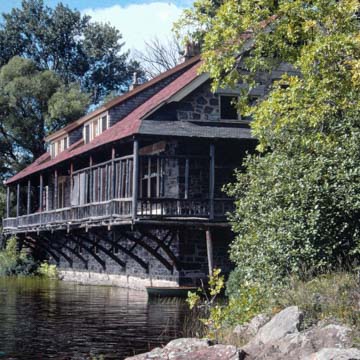You are here
Stone House (John and Mary Beecher Longyear Summer House)
Overhanging tranquil Ives Lake against the backdrop of the Huron Mountains is John Longyear's rustic summer house. Like Granot Loma ( MQ24), Longyear's retreat employs the Adirondack Rustic style to its fullest. Tucked against the rocky shore, the gabled granite cottage exposes its lower story as the site drops down to the water's edge. A wooden porch supported and braced by cedar posts and brackets thrusts itself from the building over Ives Lake. The rosemaling decoration, a Scandinavian folk technique of painted and carved floral motifs, used in the interior probably derives from Longyear's visits to his mining operations in Spitzbergen, Norway. Adjacent to the summer house was his farm. Nearby, where the Pine River empties into Lake Superior, is the Huron Mountain Club (Huron Mountain Shooting and Fishing Club) that Longyear, Horatio Seymour Jr., and other Marquette and Detroit businessmen founded in 1889 as a private natural and wildlife reserve where members could enjoy hunting, fishing, and outdoor life. The club and its members gradually acquired twenty-one thousand acres of land. Here, inaccessible to the public but visible from the lake, the rustic but comfortable T-shaped, pine log clubhouse (1892, Demetrius Frederick Charlton) complements its natural surroundings and served as a residence for visitors until the first cabins were erected in 1894. Since then, forty-six wooden and log cabins and camps that harmonize with nature have been built on either side of the Pine River. Members included affluent Michigan families like the Fords, Algers, Ferrys, Newberrys, and Angells—many of whom exploited the resources of the wilderness but saved this particular wilderness as sanctuary and hideaway for themselves. The Huron Mountain Club was a unique midwestern expression of the elaborate, rustic summer retreats in the Adirondack Mountains.
The Stone House was built next to the Longyear's Emblagaard Dairy Farm, which he established in 1893 as a model farm with a dairy building and cow stable and modern and convenient houses. Today Huron Mountain Wildlife Foundation owns Stone House.
Writing Credits
If SAH Archipedia has been useful to you, please consider supporting it.
SAH Archipedia tells the story of the United States through its buildings, landscapes, and cities. This freely available resource empowers the public with authoritative knowledge that deepens their understanding and appreciation of the built environment. But the Society of Architectural Historians, which created SAH Archipedia with University of Virginia Press, needs your support to maintain the high-caliber research, writing, photography, cartography, editing, design, and programming that make SAH Archipedia a trusted online resource available to all who value the history of place, heritage tourism, and learning.


